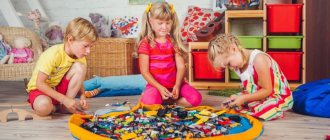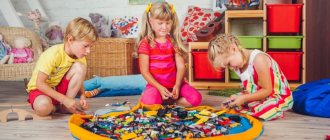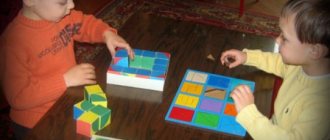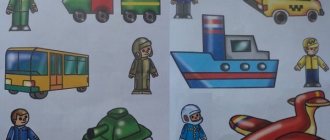At three years old, a child should have learned basic concepts, thanks to which the basic foundation for his intellectual development will be laid. Usually, parents prefer to conduct such classes at home, in a calm environment (since often a three-year-old child has some fear of society and peers: in group classes, many kids look at each other, ready to correct even the correct answer if it differs from someone else’s). What activities should you conduct with three-year-old children?
Classes with a 3-year-old child are an exciting activity: learning colors
Games and activities to develop sensorimotor skills
What's new at this age:
- We play with clothespins (we attach clothespins to templates, transfer pieces of foam rubber using clothespins);
- Winder games;
- Making soap foam (learning to whisk, blowing bubbles through a straw);
- We find objects in the bag by touch;
- We learn to organize objects, focusing simultaneously on color and size, or color and shape;
An example of a toy suitable for this is cylinders (Labyrinth, My-shop, KoroBoom)
- We play with nuts (remember their names, sort them by type, take them out of the bag by touch);
- Playing with tweezers;
An example of baby tweezers and other useful tools for motor development
- Playing with sensory boxes;
- We play with a knocker (with nails);
Example of a knocker: Ozon, My-shop, Babadu
- We assemble the nesting doll by combining the pattern on its parts;
Example of a nesting doll: Labyrinth, My-shop, Daughters & Sons
- We assemble puzzles from 4-20 parts;
Puzzle example: Ozon, Labyrinth, My-shop
- We find the missing fragments on a homemade puzzle;
- We do finger exercises with finger toys;
Example of finger toys: Ozon, My-shop, KoroBoom
- We select bolts and nuts according to size and fasten them;
- We select the keys to the locks;
- Place pasta/buttons along the lines;
- We play with a pipette, pouring water into the cells; we play with a rubber bulb and a dispenser;
Example of a pipette
- Cut with scissors;
Example of notebooks for cutting - Kumon: Labyrinth, My-shop, Ozon
- Playing with construction sets;
Here you can find a selection of construction sets for children aged 2 years and older; and here are options for the first buildings made from cubes.
- We construct from counting sticks;
- We play with a lacing tablet;
Lacing example: Ozon, KoroBoom, My-shop
- Playing with kinetic sand;
Example of kinetic sand (Ozon, My-shop)
Already familiar games:
- We build paths from dominoes;
- Pour water from one bowl to another using a sponge;
- We make a picture using puzzle cubes;
We try options from 4 cubes: Ozon, Labyrinth, My-shop
and from 9 cubes: Ozon, Labyrinth, My-shop
- We play with two or three-layer frame inserts;
Example of three-layer and two-layer puzzles
- We play fishing with pyramid rings;
- We select lids for jars;
- We play with inset frames without background pictures;
Examples of frames: Labyrinth, My-shop, KoroBoom
- We play magnetic fishing;
Examples of fishing: Ozon, KoroBoom, My-shop
- We play mosaic;
Examples of the first mosaics: Ozon, Labyrinth, My-shop
- We open and close boxes with different closing/latching options;
- We learn to open and close locks, latches, etc.;
An example of a board with locks (My-shop, KoroBoom) or a busy board
- Pour water from the teapot into glasses;
- Sift the cereal through a strainer;
- We cut vegetables and fruits;
Example of a set of vegetables (Ozon, My-shop, Labyrinth)
- We play lotto;
- Picking mushrooms/berries;
- We dress the dolls by putting on clothes;
Examples of kits for dressing dolls (Ozon, My-shop)
- Roll the ball/ball along the slide/grooves;
An example of a bowling alley (Ozon, Labyrinth, My-shop)
- Peel the boiled egg;
- We learn to unfasten Velcro, zippers, unscrew and tighten bottle caps;
Examples of toys useful in this matter:
DIY educational mat
Book “I dress myself” (Ozone, Labyrinth, My-shop)
Board with fasteners (My-shop, KoroBoom)
Household
What should a child learn?
- Putting on clothes independently.
- Cutting out pictures.
- Coloring pictures.
- Knowledge of basic rules of accuracy.
At 3 years old, a child needs to be taught self-care.
If classes are held at home, then hang posters with hygiene rules throughout the apartment - when passing by them, the child will subconsciously remember them (remember that a child of three years old can be taught very quickly, but a teenager of 16-17 years old nothing can be taught anymore).
Also strive to develop creativity in your son or daughter: at least once every 2-3 months, organize themed parties, for which you can prepare costumes, decorations, scripts and even simple dishes.
In this way, you will gradually encourage your baby to live independently, developing creativity in the meantime.
If you don’t have enough time to carry out such events, then try to at least sometimes prepare crafts from ordinary household items: birds from cups, houses from boxes, and so on.
Modeling
- Educational games with dough;
- Modeling from plasticine . Simple craft ideas: part 1, part 2.
Speech development
- We learn finger and gesture games;
- We do articulation exercises;
- Doing breathing exercises;
- We recite special poems together that encourage the pronunciation of sounds and words;
- Speech development games
For example:
Game "Repeat" . An adult pronounces words loudly, quietly or in a whisper. The child repeats with an appropriate level of volume.
Game “What is this for? ” An adult asks why this or that object is needed (table, chair, closet, bed). The child answers.
Game "Wrong Fairy Tale" . An adult tells some well-known fairy tale (Kolobok, for example) with errors. The child corrects, etc.
LiveInternetLiveInternet
Exercises and educational games for a child of the second year of life.
Classes with children from one to two years are aimed at further development of psychomotor, sensory, thinking, speech and other areas.
The most important is the competent selection of play materials, toys, objects, by playing with which the child learns to understand their properties (size, shape, color), and gradually move from manipulation to performing various, purposeful actions. By completing the task of grouping objects by size, shape, color, the child simultaneously trains memory, develops fine motor skills of the fingers, thinking, perception, etc.
The child’s speech develops in connection with the designation of objects and actions with them. A child can only talk about what he directly perceives. Books with pictures, reading and memorizing short poems and fairy tales are of great importance for the development of speech at this age.
Activities with a child of this age are different in that the adult almost always carries out joint actions with the child.
Exercises to develop sensory abilities.
— Exercises with a pyramid.
Show your child how to remove the rings from the pyramid shaft and put them back on. Give your child the opportunity to do this exercise as many times as he wants. At this stage, you should not demand from the baby that he assemble the pyramid correctly - first he must practice the skill of putting the ring on the rod.
At the second stage, tell your child that rings have different sizes, and show him two rings - a large one and a small one, say: “Let's put on the big ring first, and then the small one.”
At the third stage, teach your child to lay out the removed rings to the right of the rod in order, taking into account the size, and then take these rings one by one and put them on the rod.
If the child copes with the tasks and shows interest, offer him more complex options: assemble a pyramid in the reverse order, from smaller ring to larger one, assemble a pyramid from randomly mixed rings, assemble a pyramid from mixed rings of any two colors. Exercises with the pyramid can be performed with the child throughout the second year. Be patient and help your child using different techniques: verbal reminder (“don’t miss the ring,” “don’t turn it over,” “put it on correctly”); showing if the child completes the task incorrectly; collaboration; visual-tactile control (grasping the baby’s hand with your hand, move it from top to bottom along the surface of the pyramid: “What a smooth pyramid we have turned out to be”).
— Exercises with pyramids of various shapes (from one year to four months and older).
To complete this task, you must have pyramids of different shapes, but the same size: round and square. Show your child both pyramids, explain that one has all round rings, and the other has square bars. Together with your child, assemble pyramids. Take them apart again. Ask your child: “Show me where the round rings are and where the square bars are?”
Help your child arrange the pieces in a row (round on one side, square on the other) and then fold one round pyramid and the other square.
Take the child’s hand in yours and move it along one pyramid: “Look how smooth it is,” and along the other: “But this pyramid is completely different, with sharp corners.”
The child cannot yet independently align square bars on a rod. The main purpose of this exercise is to become familiar with objects of different shapes.
— Exercises with a matryoshka doll.
At first, from about one year two months, a matryoshka doll with one insert is used. Teach your child to open and close the matryoshka doll, put it in and take it out.
Show your child a large nesting doll, shake it - something rattles inside. Help the baby open the nesting doll, show the second, small nesting doll. Close the large matryoshka doll and place it next to the small one. Pay attention to their size: “One doll is big, the other is small.” Ask your child: “Where is the big matryoshka doll and where is the small one?”
Now open the large nesting doll, hide the small one in it and invite the child to close it with the other half, tightly connecting the two halves, and align the pattern.
Help your baby open and close the nesting dolls.
If the child has learned to operate with this nesting doll, offer him a more complex option: with two inserts.
First, you take out and collect all three nesting dolls, line them up in a row, and emphasize the difference in size. Ask your child to show where the big matryoshka is, where the middle one is, where the small one is.
Then you collect the nesting dolls together with the child: the smallest one hides in the middle one, and now there are two matryoshka dolls left (large and smaller), open the large doll and hide the middle one in it.
Constantly prompt your child: “Open this nesting doll, and now this one,” “How to close the nesting dolls?”, “Let’s make them beautiful, match the drawings,” “Take a large nesting doll, put a medium one in it,” etc. For a child of the second year of life, these exercises are quite difficult, especially such actions as combining a picture, correctly selecting parts of one toy from those randomly placed on the table.
— Exercises with objects of different sizes.
Continue to develop your child’s ability to navigate objects by their size and shape. For this exercise, you can make the necessary aids yourself in the form of circles, squares, triangles, ovals (5 pieces of large size and 5 pieces of small size). These can be figures cut out of thick cardboard.
It is important that identical figures are the same color. For example, all circles are red, all squares are blue, all triangles are green. That is, the differences are only in size and shape. The diameter of large circles is approximately 4-5 cm, small ones - 2-3 cm; the sides of the large square are 4-5 cm, the small ones are 2-3 cm; dimensions of the large triangle: 4.5x4.5x4.5 cm, small - 3x3x3 cm; ovals: 5×3 cm and 3×2 cm.
First, show the child only the circles, explaining how they differ: “Look, these are big circles, and these are small. Let’s put the big ones in one box and the small ones in another.” Complete this task yourself, asking your child where to put the big circle and where the small one (the small one is hidden in the palm, but the big one is difficult to hide). Then invite your child to arrange the circles on their own.
If the child has completed this task, move on to other figures, proceeding in the same way.
And only after the child accurately divides all the figures by size, begin to lay out the figures in accordance with their shape. First, offer your child two types of shapes of the same size, for example, small circles and small squares. Together with your child, place the circles in one box and the squares in another. Next, move on to the next pair of figures.
Act gradually, take your time, maintain the child’s interest in activities (call the figures toys, use words: like this, not like this, identical, different; do not require the child to pronounce and remember the names of the figures).
— Exercises with long and short bands.
This activity will help your child understand the differences between words of different lengths. Take two sticks with ribbons attached to them: one short - 5 centimeters, and the other long - 20 centimeters. Teach your child to wind the ribbon around the stick. When the child masters this skill, invite him to play to see who can wrap the ribbon on a stick faster. Take a short one for yourself. Be sure to win. After this, lay the ribbons on the floor and show how they differ in length. Ask the child: “Which ribbon will you take now, a short one (here it is) or a long one, like this one?” Either way, give your child a short ribbon and run the competition again. Now, of course, you must lose. Check again where the tape is short and where it is long. Come back to this game in a few days. — Exercises with boards.
You can use any surface with holes cut in them so that the child can insert the corresponding parts into them.
You need to start classes with a one and a half year old child with the simplest board. Its size is approximately 30x15 cm. The size of the cut out circles in diameter is: large - 4.5 cm, small - 3 cm. Tell the child: “Let’s play this game with you. Here is a house with windows, they need to be closed at night. Here are the big windows, and here are the small ones. Find the big circles. Cover the big windows with them. Close the little windows with small circles.”
First, ask your child to find a large circle and show them which window they need to close. To make the task easier, place large circles on the left of the board and small ones on the right. Then mix both large and small circles and help your child correctly compare the sizes of objects.
Next, move on to more complex tasks using other geometric shapes.
As you approach two years of age, complicate this task by offering your child boards with different geometric shapes cut out on each of them: circles and squares, triangles and circles, ovals and squares, etc.
The most difficult tasks are those involving nesting figures of similar shapes: circles and ovals, squares and rectangles.
If the child is unable to complete the tasks correctly, move on to sequential fractional division, which consists of carefully examining the holes and inserts, palpating with the hand, matching and comparing, the method of grasping the inserts, trying them on to the holes, and finding the right angle for closing the holes.
— Exercises with objects of different colors.
Choose sticks, cubes or other objects of different colors: for example, 5 red cubes and 5 green cubes.
1) Take one red cube and ask the child to find the same cube, then take a green cube and ask the child to find the exact same one.
2) Put one red cube in a box, ask the child to find the same cubes and put everything in the same box. Then mix the red and green cubes again and do the same task with the green cubes.
3) Now take two boxes: put a red cube in one, a green cube in the other, and the child arranges the rest according to color.
4) Use cubes (5 pieces each) of three colors: red, green, yellow. If your child has difficulty completing these tasks, help him by grouping the cubes by color, that is, do not mix them.
Exercises to develop psychomotor skills.
- Jumping.
Supporting the child by the arms or under the armpits, invite him to jump up and down in place, saying: “Jump-jump, jump-jump. The woman sowed peas, jump-jump, jump-jump. The ceiling collapsed, jump-jump, jump-jump.”
Do this exercise daily. When your child is doing well, play jumping bunnies with him. The next exercise to improve this skill could be the following game: take a toy in your hand and lift it up, holding it at a short distance from the child’s head, let him try to jump and reach it with his hand.
- Peekaboo.
Hide from the child, let him look for you. Shout to him: “Ay! Look for me! When the child finds you, pick him up in your arms, spin him around slightly, rub him, causing positive emotions. Then teach the child to hide himself, and you will look for him. Don't do this for too long, but let the child hear you call him and watch you. At this age, children usually cannot tolerate this situation for a long time and come out of hiding on their own.
- Lasagne.
1) Place a bright toy on the sofa. To get it, the child will have to climb onto the sofa and get down to the floor.
2) By attracting the child’s attention with some bright object, encourage him to crawl on all fours under the chair.
3) Teach your child to climb in and out of, for example, a large box. Help him at first.
- Stepping over.
Place different objects on the floor that your baby can step over. Take him by the hand and walk around the room. Whenever your child stops in front of an obstacle, help him lift one leg high, then the other, and step over the object. - Ball games.
1) Give the child a small ball and help him throw the ball onto the floor. Now place the ball next to the baby, let him pick it up and then throw it. The next step is learning to catch the ball, or more precisely, to grab it.
2) Sit with your child on the floor opposite each other, spread your legs to the sides and roll the ball to each other. Gradually increase the distance between you and your baby.
3) To develop coordination of movements, use games with balloons. First play with one ball, and then with two or three. For example, you need to prevent the balls from falling to the floor by constantly throwing them up.
4) To develop your eye, throw the ball into a small cardboard box. At first this distance should not be large, gradually increase it. Help your child do this exercise, do not strive for results, but to arouse the child’s interest in this activity.
— Drawing with pencils.
Teach your child to hold a pencil in his hand, notice pencil marks on paper, and most importantly, try to arouse interest in drawing.
Draw with your child, holding his hand with a pencil in yours. First, draw, for example, raindrops. Tell your child a story about rain, poetry or sing a song:
Rain, rain, drip-drip-drip. Rain, rain, more fun, Drip, drip, don’t be sorry! Sprinkle more in the field: The grass will become thicker!
Draw a cloud on a piece of paper in advance, and then, together with your child, apply droplets of rain with strokes. Discuss the first drawing, ask the child: “Where does it rain the most?”
— Drawing with paints.
Prepare a sheet of paper and three colors of paint (red, yellow, blue). First, give your child a dry brush and encourage him to make a few dry brush strokes on a piece of paper. After preliminary exercises in dry dabbing, you begin to paint with paints together with your child.
Show your child how to carefully dip a brush into the paint: “Look, there’s a small bunny figure on the tip of the brush. This is how a bunny jumps - jump-jump, jump-jump." And colorful spots of color appear on the paper.
And then draw the fall of leaves: “The breeze blew and the leaves flew from the tree, fell on the grass - the leaves are falling, falling, leaves are falling in our garden.” Admire the picture of leaf fall with your child.
— Modeling from plasticine.
Show your child a small piece of plasticine, make a ball out of it, place it on the board and press with your finger. Ask your child: “What did you and I have? “balloon, what happened?” Invite the child to make a cake out of the ball himself, and then together make a carrot, pancakes for a doll, etc. Draw the child’s attention to the variability of shape, help him find similarities with objects.
Exercises and games to develop cognitive and speech activity.
- Look at picture books.
Try to attract your baby’s attention to looking at pictures in books as much as possible. Talk to your child, showing pictures of animals, objects familiar to the child, and people. Ask him questions: “Show me where the pussy is?”, “How does the pussy meow?”, etc.
- Read poems, nursery rhymes, counting rhymes to your child, sing songs.
Don’t forget folk art: continue playing “Horned Goat”, “Ladushki”, “Magpie-with-a-Pube”, “Fingers in the Forest”.
Gradually expand the sound and speech environment in language acquisition. Don’t be alarmed by the fact that your child still doesn’t understand much.
In the second year of life, you can read to your child such poems by Agnia Barto, such as: They dropped the bear on the floor, They tore off the bear’s paw. I won’t leave him anyway, because he’s good.
The bull walks, sways, Sighs as he goes: “Oh, the board is ending, Now I’m going to fall!”
I love my horse, I will comb its fur smoothly, I will smooth its tail with a comb, and I will go on horseback to visit.
The owner abandoned the bunny, The bunny was left in the rain - He couldn’t get off the bench, He was wet to the skin.
Try to accompany the reading of each poem with imitation of appropriate actions that are understandable to the child.
- Games with a doll.
Play with dolls with girls and boys. Come up with little stories from the doll's life. Show your child how to dress her, feed her, walk with her, etc. Constantly encourage your child to communicate through gestures and actions. Ask your child more questions. For example: “Anechka, look what girl came to visit us. Let's say hello. Give her a pen. What is the name of such a beautiful girl?”, etc.
- Role-playing games.
Towards the end of the second year, start playing with your child various games that involve imitation animals that the child is familiar with.
For example, play the game “Cat and Mouse”. Give the child the role of a mouse, and take the role of a cat for yourself. The “cat” walks around the room, and the “mouse” hides. Then the “cat” went to bed, and the “mouse” came out of its hiding place. The “cat” woke up, stretched, meowed, and the “mouse” needs to run away to its house (agree in advance with the child where it will be). Next, change roles with the child.
Or play “Teddy Bear”. Show your child how the bear cub moves, how it growls and shakes its head. Now the child pretends to be a bear, and you read him a poem:
The clubfooted bear walks through the forest, collects cones and puts them in his pocket. Suddenly a cone fell right on the bear's forehead. The bear got angry and stomped with his foot!
Teach your child to portray other animals: birds, frogs, horses.
source
Series of messages “Children 2-3 years old.
Lesson notes": Part 1 - A comprehensive lesson on speech development and modeling in the first junior group on the topic: "Kolobok" Part 2 - Long-term planning of art classes in the junior group... Part 8 - Sample notes on modeling classes in the first junior group Part 9 — Creativity for the little ones Part 10 — Exercises and educational games for a child of the second year of life. Part 11 - Mental development of a child of the third year of life Part 12 - Exercises, educational games for a child of the third year of life Part 13 - How your child develops. Home tests Part 14 - Sleepy positions. Night indicator
Reading books
Collections of books for reading to children 2 years old can be found here:
- TALES AND POEMS OF RUSSIAN AUTHORS
- TALES AND POEMS OF FOREIGN AUTHORS
- DEVELOPMENTAL BOOKS
- WINTER AND NEW YEAR BOOKS
First lessons
- We learn to count - we play the first mathematical games;
- We study geometric shapes;
- Learning colors;
- Playing with words and letters;
- We teach who lives in which house (a squirrel - in a hollow, a dog - in a booth, a mouse - in a hole, etc.);
- We teach who eats what (monkey - bananas, hare - carrots, mouse - cheese, etc.)
- Getting to know the seasons;
- We learn to classify objects into groups (clothing, dishes, transport, furniture, etc.), find what is superfluous in a group of objects;
- Remember the names of the fingers;
- We look through Doman’s cards (we study simple facts using them) or other didactic material that expands the child’s horizons;
How to teach a child to read correctly or Which method of teaching reading to choose?
Gone are the days when children who could not read were sent to school. Nowadays, children are being introduced to literacy much earlier, and this responsibility, as a rule, falls on the parents. Some teach children the “old fashioned way” - the alphabet and syllables, while others, on the contrary, take up modern methods of teaching reading, of which there are many now (the most popular of them are the methods of Doman and Zaitsev). What approach should you choose to make learning enjoyable and for your child to really develop a love for books? After all, you can praise a new modern method as much as you like, but if classes on it are carried out under pressure and only spoil your relationship with your child, then it is worthless.
Today I will try to highlight the basic methods of teaching reading, their advantages and disadvantages, and also talk about how to interest a child in reading. I really hope that the article will help you decide on the direction in which you need to move. Well, read about specific games and activities in the new section “Learning to Read.”
Logic games
For example:
- We play with Dienesh's logic blocks;
- We lay out simple patterns;
- We assemble simple patterns from Nikitin’s cubes “Fold the pattern”
and etc.
More logic games can be found in the article “Logic games for children 2-3 years old”
Role-playing games
Ideas for simple story games can be found here and here. From about 2 years old, a child becomes interested not only in watching the scenes that you show him, but also in participating in them himself. Therefore, invite your child to take on some role during the game. Act out simple fairy tales (turnip, bun, hen, etc.).
A two-year-old child and the peculiarities of his thinking
Psychologists say that the second year of life for children is a period of crisis. They begin to actively study the world around them and realize the difficulties it can bring them.
On a note! The task of parents is to help the child overcome the crisis period.
Parents often make a big mistake, believing that at two years old it is not worth teaching a child anything, since he will not understand. But when they begin to raise him, it turns out that time is lost. In the first five years of a child’s life, the foundations of education are laid. The most important years are considered to be 1.5-2.
At the age of two years, the child should speak. Thanks to this, the development of his self-awareness accelerates. It is through speech communication that he receives most of the information that is necessary for development. It is important for parents to pay as much attention as possible to speech formation during this period. At the age of one and a half years, the baby already knows how to call a spade a spade. By the age of two, he already develops the ability to combine up to three words into a phrase.
Important! When a child reaches his third year, his thinking changes from visual-effective to visual-figurative. It differs in that all actions with material objects are replaced by images. The internal development of thinking is based on the formation of concepts.
By the end of the second year, children begin the “why” period. The child becomes persistent, he demands an answer to the question posed. The attitude towards the answer received is already expressed. At three years old, the child begins to see himself from the outside; he is already able to control his behavior.
Features of development
Music classes
- Listening to classical music;
- We play simple outdoor musical games;
Physical activity
- We walk on a massage mat (Ozone, My-shop);
- We learn to walk along a line or footprints taped to the floor;
- We learn to jump up, trying to touch an object located just above outstretched arms;
- We learn to jump over a rope or obstacle 10-20 cm wide.
- Learning to stand on one leg;
- Learning to walk on tiptoes;
- We throw small balls or pebbles with one hand into the distance, throw the ball with both hands from behind the head;
- We throw balls at a horizontal target (for example, a basket standing on the floor);
- We get used to doing exercises in the morning;
- We learn to act on a signal. For example, the following motor games will be useful:
Game "Traffic Light" . The adult says “Green” (or shows a green card) - the child walks or pretends to be driving a car. The adult says “Red” (shows the red card) - the child stands.
Game "Planes" . On command, we start the engines (rotate our arms in front of our chests, say “rrrr”), take off (arms to the sides), go for landing (slowly stop, lower our arms).
Game "Day-Night" . When an adult says “day”, the child runs, when “night” he freezes and “sleeps”.
Night terrors: why they happen and what to do about them
What are nightmares
Nightmares are sleep disturbances in which a child may suddenly cry, scream, moan, or mutter in bed with eyes wide open but not awake. Because she is stuck in a sort of twilight zone between sleep and wakefulness, she is unaware of your presence and is unlikely to respond to anything you say or do. The episode lasts anywhere from two to 40 minutes, and when it ends, your child suddenly goes back to sleep with no memory of the incident.
How are nightmares different from night terrors?
Sixtine fights a monster in her bedroom in Laure Fauvel's “Terreurs”, 2014, in Paris, France.
An imaginative photographer has brought to life monsters that haunt children's nightmares. Armed with sticks, wands and swords the eight and nine year-olds appear to be getting the upper-hand against the villains. Parisian photographer Laure Fauvel, 22, said: I wanted the children not to be victims and to fight the monsters. (Photo by Laure Fauvel/Barcroft Media) Unlike a night terror, a nightmare leaves your child truly awake—she can remember the dream and sometimes talk about it. In addition, children have nightmares during sleep, often in the early morning hours between 2 and 6 am. On the other hand, they usually experience night terrors in the first few hours of the night during deep, dreamless sleep.
The easiest way to tell the difference between a night terror and a nightmare is to ask yourself who is more upset that morning. If your child is more agitated, he had a nightmare. If you're the one who's concerned, she probably had a night terror. The “horror” lasts much longer for the parent who observed it than for the child who experienced it.
What causes nightmares and can they be prevented?
There is no definitive way to prevent nightmares because no one knows for sure what causes them. Nightmares can occur due to erratic or inadequate sleep patterns or any type of sleep deprivation. They are caused by stress during the day or excessive fatigue. What will be known is that, by themselves, nightmares do not mean the child has a psychological problem.
Addressing any other sleep problems your child has (such as getting up in the middle of the night) and ensuring they have regular, calming bedtimes and get enough hours of sleep can help prevent night terrors. In some cases, nightmares are caused by sleep apnea, a serious but treatable disorder in which enlarged tonsils and adenoids (normal tissue in the throat) block the airway during sleep, making breathing difficult and causing the child to become partially awake.









